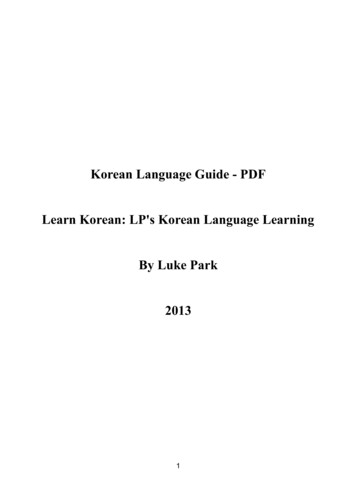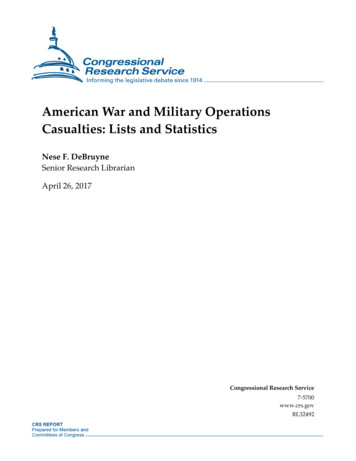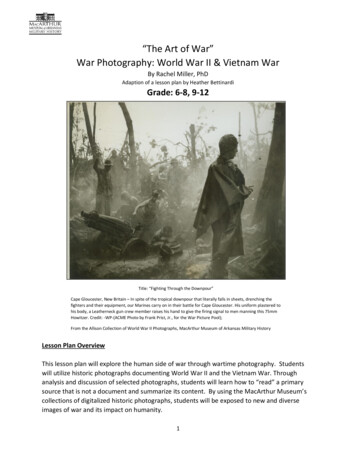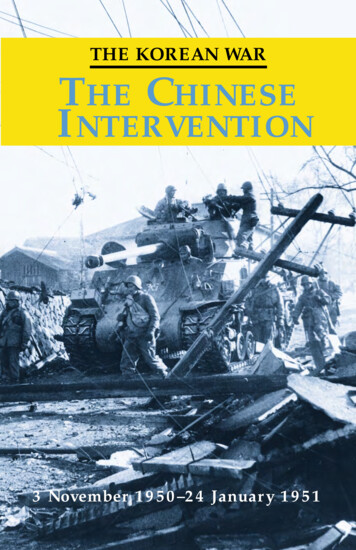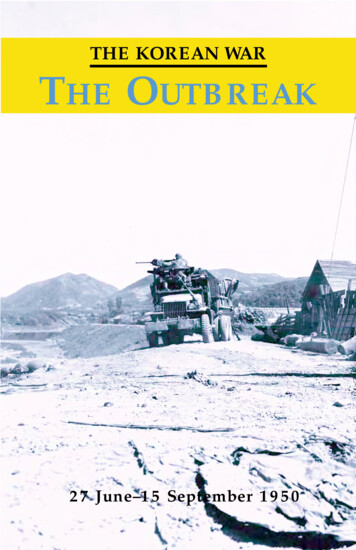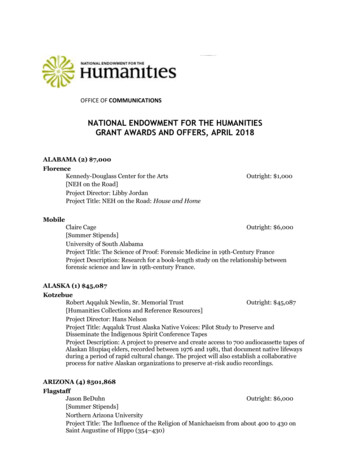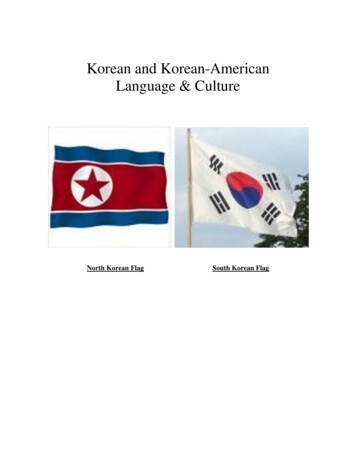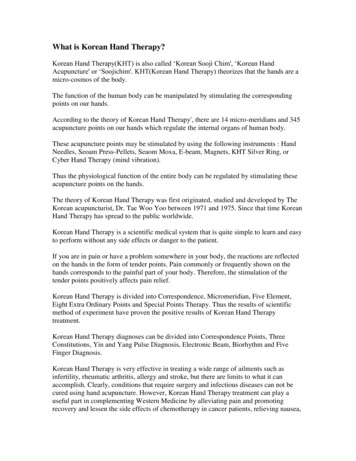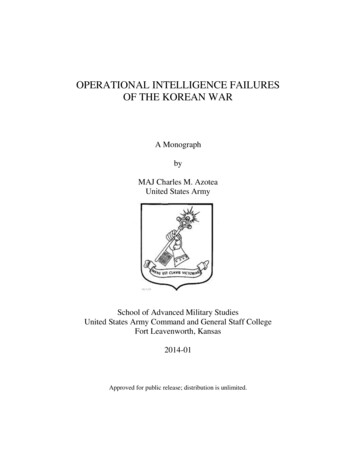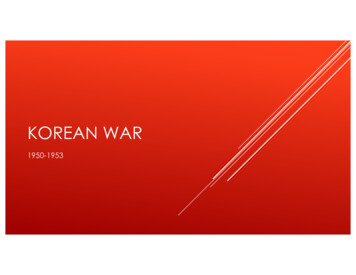
Transcription
KOREAN WAR1950-1953
KOREA BEFORE THE COLD WAR Five Facts Videohttps://www.youtube.com/watch?v h1wFrXKanC0After the conclusion of WWII in September 1945, the Soviet Union declared war onJapan; this was done in agreement with the United States. Japan had ruled over Korea for more than 30 years. To weaken Japan’s power, the SU liberated the northern part of Korea and the US occupiedthe southern region. By 1948, the relationship between the SU and US soured.Neither the SU nor the US wanted to give up their influence in Korea; as a compromise,Korea was split into two at the 38th Parallel. North à Democratic People’s Republic of Korea Supported by the SU and Chinese Communist PartySouth à Republic of Korea Supported by the US and had democracy US hoped the division would keep the peace and prevent the spread of Communism in Asia. The goal was to have the split be temporary but neither side wanted to give up their loads/1/4/9/8/14984354/3979366.png?0
HOW THE WAR BEGAN After growing tensions, North Korea invaded SouthKorea by crossing the 38th Parallel on June 25, 1950. North Korea’s goal à Unite North and South Koreaunder one government independent of foreigninfluence. North Korea saw the separation of the country as thefault of unwanted American interference and theywanted to free South Korea from the grip of the US. invades-south-korea.jpgThe SU and communist China were backing NorthKorea. The US was very surprised because their focus hadbeen on stopping the spread of Communism inEurope; they really weren’t prepared to deal withsomething in Asia. The South Korea army was no match for the NorthKoreans, who swiftly t/uploads/2011/06/1.jpg
SENDING IN THE TROOPS United Nations (UN) Security Council immediately called for a ceasefire but the North Koreans continued to attack. Top US advisors decided to take action; they were determined to notlet another Asian nation fall to Communism since many felt they “lost”China years before. logo.gifContainment policyOn June 27, 1950, the UN Security Council called on UN members tosupport South Korea; the SU ambassador was absent. “I have ordered United States air and sea forces to give the Koreangovernment troops cover and support.” –President Harry S Truman Badly needed troops were sent in by the US and 15 other nations; this wasthe first time UN troops fought together in a major conflict.General Douglas MacArthur became the commander of the UN forcesin July 1950; the fighters were mostly from the US and South 25b-51b1-45b3-999aa6e640f78042%2Fmacarthur7.crop 344x25856%2C0.preview.jpg?profile max500x190
HOW THE FIGHTING WENT By September 1950, the North Korean troopshad taken everything but the southeastern tipof Korea; fighting raged there for six weeks. MacArthur and other military leaders cameup with a daring plan at a port city, whichallowed them to launch a surprise attack onthe North Koreans from behind their lines. UN forces quickly drove the invading NorthKoreans out of South Korea. In just over a month, MacArthur captured theNorth Korean capital of Pyongyang. Soon, UN forces reached the b/vzeEOdEwGBbcBcTV7jyNpJMrQ1g /640x480/filters:no 073df78cafdaa0b5e8.jpg
THE FIGHTING CONTINUES Some Chinese troops began fighting alongside theNorth Koreans earlier in the war, and soon thousandsmore backed the NKs. UN forces were pushed back across the 38th Parallel. MacArthur called for air and ground troops toattack China, but Truman refused. MacArthur openly criticized Truman in a letter bystating, “There is no substitute for victory.” Truman ultimately relieved MacArthur of his commandin April 1951.https://www.dw.com/image/44687346 303.jpgUN forces managed to push the blended NorthKorean and Chinese troops back across the tent/uploads/2017/04/M20 75 mm recoilless rifle korean war.jpg
ENDING THE WAR By Spring 1951, it was clear that neither side would achieve victory. “Everybody could see that we had reached stalemate, unless someone started chucking atombombs.” –British soldierPeace talks began in July 1951. The American public soon grew frustrated with the lack of progress. The war became a major topic in the 1952 election; Truman chose not to run for reelection,knowing many blamed him for the US’s involvement.After Dwight D. Eisenhower won the election, he traveled to Korea. Peace talks did not yield results and more soldiers kept dying as fighting flared up. Eisenhower brought up the possibility of using atomic weapons.A cease-fire was signed on July 27, 1953, essentially ending the fighting. Korea was again divided roughly along the 38th Parallel. A narrow demilitarized zone (DMZ) was made between the two countries; soldiers are still there today.Significant casualties: 1.5 million NK/Chinese soldiers, 845,000 SK soldiers, 155,000 US forces, and 3million NK and SK civilians
SO THE WAR IS OVER, RIGHT? Technically, the North and South Koreans had only signed a truce. The Armistice Agreement formally ended fighting and divided the Korean peninsula,but it was not a peace treaty. Technically, North and South Korea are still at 4/Korean-War-Memorial-Washington-DC-Tour.jpg
RESULTS OF AND AFTER THE KOREAN WAR In one sense, the Korean War changed nothing since theborder between the two countries remained about the sameand the north remained Communist. On the other hand, the Korean War pushed back theinvasion of the North Koreans, essentially maintaining SouthKorea’s democracy and showing the world that the US wasready to fight Communism’s expansion into non-Communistnations. After the war North Korea’s economy – already in trouble before the war –was struggling; support from the SU and China wasn’t enough,and there are still problems with jobs and housing today. North Korea also remains under the rule of a strict Communistdictatorship. South Korea quickly ousted its leader after the war andstruggled with its economy for a while; during the Vietnam War,SK gave support to the US, and that was rewarded with 200million from the US, which boosted its economy. South Korea continues to do well ight.jpg?w968h681
KOREA BEFORE THE COLD WAR After the conclusion of WWII in September 1945, the Soviet Union declared war on Japan; this was done in agreement with the United States. Japan had ruled over Korea for more than 30 years. To weaken Japan’s power, the SU liberated the northern part of Korea and the US occupied the

